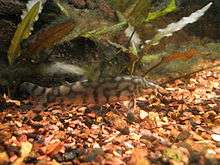Yoyo loach
The yoyo loach, Almora loach or Pakistani loach (Botia almorhae) is a freshwater fish belonging to the loach family Botiidae. It originates in the slow-running and still waters of the Ganges basin in northern India and possibly Nepal.[1][2] Despite the alternative common name Pakistani loach, the true B. almorhae is not known from Pakistan (the species in this country is B. birdi).[1][2]
| Yoyo loach | |
|---|---|
 | |
| Typical aquarium specimen labelled as Botia almorhae, but these are likely a related species (see text).[1][2] | |
 | |
| Scientific classification | |
| Kingdom: | Animalia |
| Phylum: | Chordata |
| Class: | Actinopterygii |
| Order: | Cypriniformes |
| Family: | Botiidae |
| Genus: | Botia |
| Species: | B. almorhae |
| Binomial name | |
| Botia almorhae J. E. Gray, 1831 | |
| Synonyms | |
|
Botia grandi Gray, 1832[4] | |
It may attain a length of 14–16 cm (5.5–6.3 in), and is named for its dark and pale patterns, which often can be seen to spell "yoyo" (especially in smaller/younger specimens), hence the common name yoyo loach.[1] The final common name, Almora loach, refers to Almora in Uttarakhand, India.[4] Specimens labelled as B. almorhae are commonly found in the aquarium trade, but most (if not all) of these appear to be the closely related B. lohachata, two possibly undescribed species popularly referred to as B. sp. "Kosi" and B. sp. "Teesta", or hybrids.[1][2]
References
- Froese, Rainer and Pauly, Daniel, eds. (2014). "Botia almorhae" in FishBase. 09 2014 version.
- "Botia almorhae". Integrated Taxonomic Information System. Retrieved 12 June 2006.
- SeriouslyFish: Botia almorhae. Retrieved 15 July 2014.
- Grant, S. (2007). Fishes of the genus Botia Gray, 1831, in the Indian region (Teleostei: Botiidae). Ichthyofile 2: 1-106
- Chaudhry, S. (2010). "Botia almorhae". The IUCN Red List of Threatened Species. IUCN. 2010: e.T168483A6500554. doi:10.2305/IUCN.UK.2010-4.RLTS.T168483A6500554.en. Retrieved 4 January 2018.
- Kottelat, M. (2012): Conspectus cobitidum: an inventory of the loaches of the world (Teleostei: Cypriniformes: Cobitoidei). The Raffles Bulletin of Zoology, Suppl. No. 26: 1-199.
| Wikimedia Commons has media related to Botia almorhae. |
